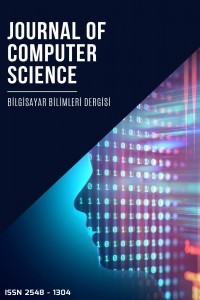KONTRASTLI ÖĞRENME TABANLI ÇEKİŞMELİ ÜRETKEN AĞLAR İLE PAPSMEAR GÖRÜNTÜ BÖLÜTLEME
PapSmear görsellerinin otomatik olarak rahim ağzı kanser varlığının tespit edilmesi aktif bir
çalışma alanıdır. PapSmear görüntülerinde nesnelerin dağılımı sürekli yer değiştirmektedir. Bu
çalışmada, Çekişmeli Üretken Ağlar (ÇÜA) ve karşılaştırmalı öğrenme tekniklerinden parça tabanlı
yöntemler kullanılarak PapSmear görüntü bölütlemesi yapılmıştır. Kıyaslanan yöntemler CycleGAN,
CUT, FastCUT, DCLGAN ve SimDCL yöntemidir. Tüm yöntemler eşlenmemiş görüntüler üzerinde
çalışmaktadır. Bu yöntemler bir birlerini temel alarak geliştirilmişlerdir. DCLGAN ve SimDCL yöntemi
CUT ve CycleGAN yönteminin birleşimidir. Bu yöntemlerde maliyet fonksiyonları, ağ sayıları
değişkenlik göstermektedir. Bu çalışmada yöntemler ayrıntılı bir şekilde incelenmiştir. Yöntemlerin
birbirine benzerlik ve farklılıkları gözlemlenmiştir. Bölütleme yapıldıktan sonra hem görsel hem de
ölçüm metrikleri kullanılarak bulunan sonuçlara yer verilmiştir. Ölçüm metriği olarak FID, KID, PSNR
ve LPIPS yöntemleri kullanılmıştır. Yapılan deneysel çalışmalar, DCLGAN ve SimDCL yönteminin
PapSmear bölümletlemede kıyaslanan yöntemler arasında daha iyi oldukları olduğu gözlemlenmiştir.
CycleGAN yönteminin ise diğer yöntemlerden daha başarısız olduğu gözlemlenmiştir.
Anahtar Kelimeler:
Görüntü bölütleme, derin öğrenme, evrişimsel sinir ağı, çekişmeli üretken ağlar, karşılaştırmalı öğrenme
PAPSMEAR IMAGE SEGMENTATION WITH CONTRASTIVE LEARNING BASED GENERATIVE ADVERASRİAL NETWORKS
Automatically detecting the presence of cervical cancer in PapSmear images is an active
field of study. The distribution of objects in PapSmear images is constantly changing. In this study,
PapSmear image segmentation was performed by using patch-based methods from Generative
Adversarial Networks (GAN) and contrastive learning techniques. The methods compared are
CycleGAN, CUT, FastCUT, DCLGAN and SimDCL methods. All methods work on unpaired images.
These methods were developed on the basis of each other. DCLGAN and SimDCL method is a
combination of CUT and CycleGAN methods. In these methods, cost functions and network numbers
vary. In this study, the methods were examined in detail. Similarities and differences between the
methods were observed. After segmentation, the results obtained using both visual and measurement
metrics are included. FID, KID, PSNR and LPIPS methods were used as measurement metrics.
Experimental studies have shown that DCLGAN and SimDCL method are better among the compared
methods in PapSmear segmentation. It has been observed that the CycleGAN method is more
unsuccessful than other methods.
Keywords:
Image segmentation, deep learning, convolutional neural network, adversarial generative networks, contrastive learning,
___
- Liu, M. Y., Breuel, T., & Kautz, J. (2017). Unsupervised image-to-image translation networks. In Advances in neural information processing systems (pp. 700-708).
- Zhou, Y. F., Jiang, R. H., Wu, X., He, J. Y., Weng, S., & Peng, Q. (2019). Branchgan: Unsupervised mutual image-to-image transfer with a single encoder and dual decoders. IEEE Transactions on Multimedia, 21(12), 3136-3149.
- Huang, X., Liu, M. Y., Belongie, S., & Kautz, J. (2018). Multimodal unsupervised image-to-image translation. In Proceedings of the European conference on computer vision (ECCV) (pp. 172-189).
- Lin, J., Chen, Z., Xia, Y., Liu, S., Qin, T., & Luo, J. (2019). Exploring explicit domain supervision for latent space disentanglement in unpaired image-to-image translation. IEEE transactions on pattern analysis and machine intelligence, 43(4), 1254-1266.
- Park, T., Efros, A. A., Zhang, R., & Zhu, J. Y. (2020, August). Contrastive learning for unpaired image- to-image translation. In European Conference on Computer Vision (pp. 319-345). Springer, Cham.
- Han, J., Shoeiby, M., Petersson, L., & Armin, M. A. (2021). Dual Contrastive Learning for Unsupervised Image-to-Image Translation. In Proceedings of the IEEE/CVF Conference on Computer Vision and Pattern Recognition (pp. 746-755).
- Yurt, M., Dar, S. U., Erdem, A., Erdem, E., Oguz, K. K., & Çukur, T. (2021). Mustgan: Multi-stream generative adversarial networks for MR image synthesis. Medical Image Analysis, 70, 101944.
- Yao, S., Tan, J., Chen, Y., & Gu, Y. (2021). A weighted feature transfer gan for medical image synthesis. Machine Vision and Applications, 32(1), 1-11.
- Chabra, S. (2016). Cervical cancer preventable, treatable, but continues to kill women. Cervical Cancer, 1(112), 2.
- Mustafa, W. A., Halim, A., Jamlos, M. A., & Idrus, S. Z. S. (2020, April). A Review: Pap Smear Analysis Based on Image Processing Approach. In Journal of Physics: Conference Series (Vol. 1529, No. 2, p. 022080). IOP Publishing.
- Fekri-Ershad, S. (2019). Pap smear classification using combination of global significant value, texture statistical features and time series features. Multimedia Tools and Applications, 78(22), 31121-31136.
- Gautam, S., Jith, N., Sao, A. K., Bhavsar, A., & Natarajan, A. (2018). Considerations for a PAP smear image analysis system with CNN features. arXiv preprint arXiv:1806.09025.
- Yi, Z., Zhang, H., Tan, P., & Gong, M. (2017). Dualgan: Unsupervised dual learning for image-to-image translation. In Proceedings of the IEEE international conference on computer vision (pp. 2849-2857).
- Zhang, R., Isola, P., Efros, A. A., Shechtman, E., & Wang, O. (2018). The unreasonable effectiveness of deep features as a perceptual metric. In Proceedings of the IEEE conference on computer vision and pattern recognition (pp. 586-595).
- Heusel, M., Ramsauer, H., Unterthiner, T., Nessler, B., & Hochreiter, S. (2017). Gans trained by a two time-scale update rule converge to a local nash equilibrium. Advances in neural information processing systems, 30.
- ISSN: 2548-1304
- Yayın Aralığı: Yılda 2 Sayı
- Başlangıç: 2016
- Yayıncı: Ali KARCI
Sayıdaki Diğer Makaleler
EVSEL ATIKLARIN DERİN ÖĞRENME TEKNİKLERİ İLE AYRIŞTIRILMASI
Yunus Emre KARACA, Serpil ASLAN, Cengiz HARK
Çekişmeli Üretici Ağlar ile Denim Kumaşından Otomatik Bıyık Desen Üretimi
Emrullah ŞAHİN, Muhammed Fatih TALU
Sinan KAMİLÇELEBİ, Sumeyya ILKİN, Suhap ŞAHİN
KONTRASTLI ÖĞRENME TABANLI ÇEKİŞMELİ ÜRETKEN AĞLAR İLE PAPSMEAR GÖRÜNTÜ BÖLÜTLEME
Sara ALTUN, Muhammed Fatih TALU
Gauss Filtreleri Kullanılarak Geliştirilen Bölge Temelli Yeni Bir Aktif Kontur Yöntemi
Verification of Karci Algorithm’s Efficiency for Maximum Independent Set Problem in Graph Theory
